- Tri-Mode Power Dissipation
- On this page I will try to help
you understand how the power is distributed in a
tri-mode configuration.
For this example, we will assume:
- The amplifier is stable
into 2 ohms stereo and 4 ohms mono
- The amplifier will
produce 100 watts per channel into 4 ohm
stereo, 200 watts per channel into 2 ohms
or 400 watts into 4 ohm mono. Read the Amplifier
Bridging
page if you don't understand why the
output power is 4 times as high when
bridged as it is for each channel in 4
ohm stereo.
- When it is said that
the load on the amplifier is increased,
it means that the impedance of the
speaker load is decreased and there fore
putting more stress on the amplifier.
- This image is a review of the
signals present on each of the speaker output
terminals of a bridgeable amplifier. All of the
lines of the same color are connected together.
You can see that the left positive output has the
'normal' signal and the right negative has the
'inverted' signal. The left negative and the
right positive are connected to a reference
(ground) and have no signal on them.
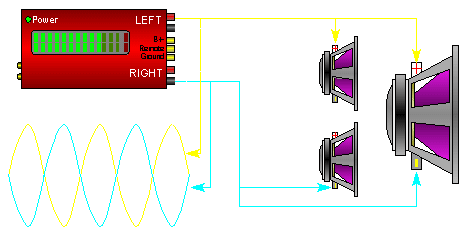
- In this diagram, you can see
that the voltage across the subwoofer is twice
the voltage of the stereo speakers. The little
'probes' show the points where the voltage would
be measured/read and the gray display shows the
voltage measured by the probes above each
display.
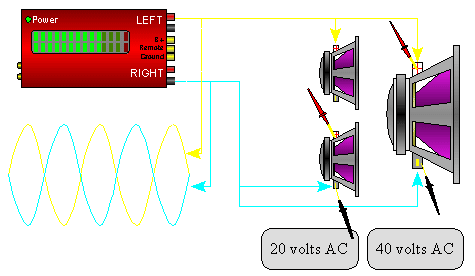
- If we use the Ohm's Law
formula: P=E^2/R
- If the small speakers are 4
ohms each and the sub is an 8 ohm speaker...
-
- We can see that the smaller
speakers will dissipate:
- P=20^2/4
P=400/4
P=100 watts per channel.
- The 8 ohm sub will dissipate:
- P=40^2/8
P=1600/8
P=200 watts into the bridged speaker.
- The total power dissipation is
100 watts for each of the 4 ohm stereo speakers
plus 200 watts into the bridged 8 ohm speaker.
The total power output/dissipation is 400 watts.
The same total power as if you were running the
amplifier into a 4 ohm bridged OR a 2 ohm stereo
load.
- Tri-mode with different types
of speakers:
- In the previous diagrams, it
was assumed that all of the drivers were woofers.
All of the speakers were directly connected to
the amplifier (no crossover components). If you
use passive crossovers (capacitors or coils), the
system will be able to drive more speakers
without increasing the effective load on the
amplifier. If the 'stereo' speakers in the
previous diagram are 4 ohms each and the bridged
speaker is an 8 ohm speaker, the amplifier will
be loaded to its maximum safe load (the amp is 2
ohm stereo or 4 ohm mono stable). Using passive
crossovers, the 'stereo' speakers could be 2 ohms
and the bridged speaker could be a 4 ohm speaker
and the load would still be a safe load. Without
the crossover components, the amp would 'see' a 1
ohm stereo/2 ohm mono total load.
- For this next example... If the
passive crossover has a crossover point of 150
hertz and the crossover components are connected
as follows:
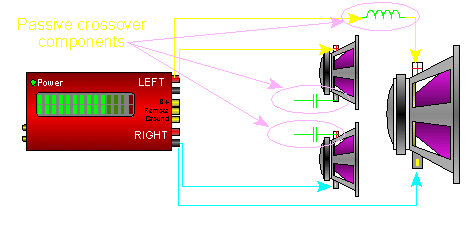
- The high frequency speakers will not load the amplifier
below 150 hertz and the low frequency speakers will not load the amplifier
above 150 hertz. In the real world, the
point where the high and low pass speakers stop
being a load on the amplifier is not as abrupt as
this and there is actually an overlap of
frequencies where both high and low frequency
drivers are a load (albeit an ever decreasing
load) on the amplifier. There is no single point in the audio spectrum where both the high frequency and low frequency drivers present their
rated impedance to the amplifier.
- On the following graph, the
violet line is the effective impedance of the high
frequency speakers. You can see how
the impedance keeps rising.
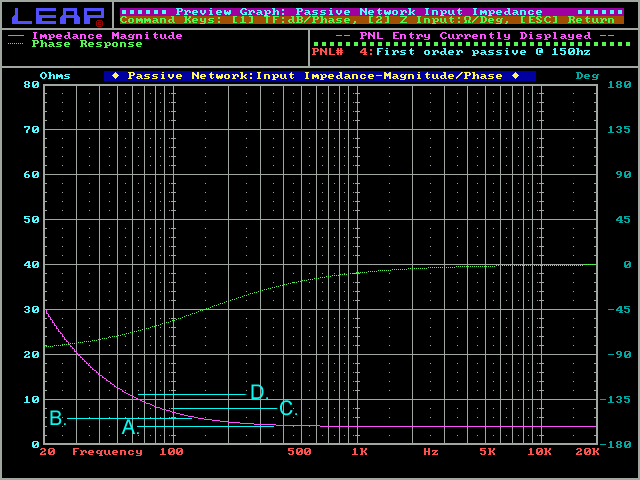
- At point 'A', the
effective impedance of the speakers is
equal to the rated impedance of the
speakers. When the line transitions from
the flat area to the knee of the slope,
the impedance presented to the amplifier
starts to increase (the amplifier 'sees'
a lighter load).
- At point 'B', the
effective impedance of the driver and
series crossover component is 1.4 times
the impedance of the driver. This is the
3dB down point of the 150hz crossover.
- At point 'C', the
effective impedance is twice the
impedance of the driver.
- At point 'D', the
effective impedance is 2.8 times the
impedance of the driver.
- This is the impedance plot of
the low frequency drivers.
The description from the previous graph also
applies here.
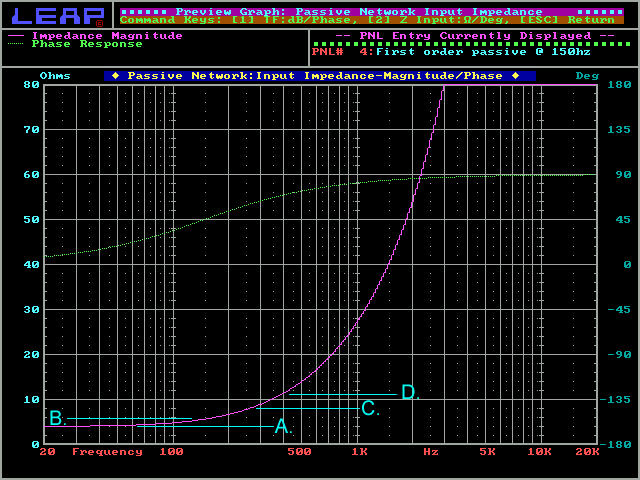
Losing
Headroom in Trimode Operation
- Loss of Headroom:
- When using an amplifier without
an electronic crossover, you lose some head room.
In the following 2 diagrams, you can see two sine
waves that have plenty of headroom. This is a
100hz sine wave.
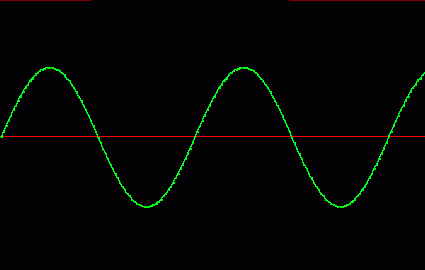
- And here you can see a 2000hz
sine wave.
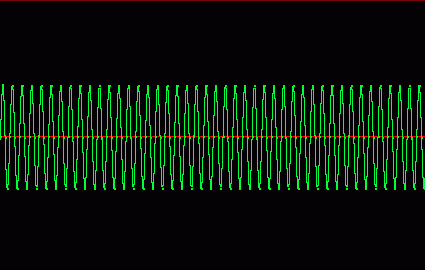
- You can see (in the previous
pictures) that neither of the sine waves are near
the top or bottom of the window (black area). In
the next picture you can see that the higher
frequency is 'riding' on top of the lower
frequency. When both of the frequencies are mixed
together (below), you can see that they are very
close to reaching the top and bottom of the
window (we will consider the upper and lower
borders of the window to be 'clipping'). You should also notice that the
individual signals are exactly the same levels
that they were before they were mixed. If the
volume were only slightly increased (above the
present volume setting), the amplifier would
start to clip. When using an electronic
crossover, the
signal in third picture is separated back into
the signals in the first and second pictures (if
the crossover point was set approximately in the
center of 100 and 2000hz).
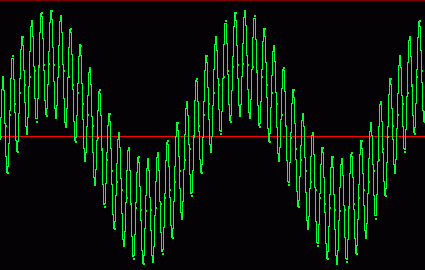
- More info on clipping:
- Read the "Too Little
Power"
page.
- Don't Panic!:
- This does not mean that a
tri-mode configuration can't sound good. It just
means that you'll have less power available to
the highs and lows when the audio has both high and
low frequency content. If the audio is a pure low
frequency sine wave, you'll have approximately
the same headroom as with an electronic
crossover. If there are multiple frequencies (as
you have with normal music), the higher
frequencies will be 'riding' on top of the lower
frequency waves and your dynamic headroom will be
reduced.
|